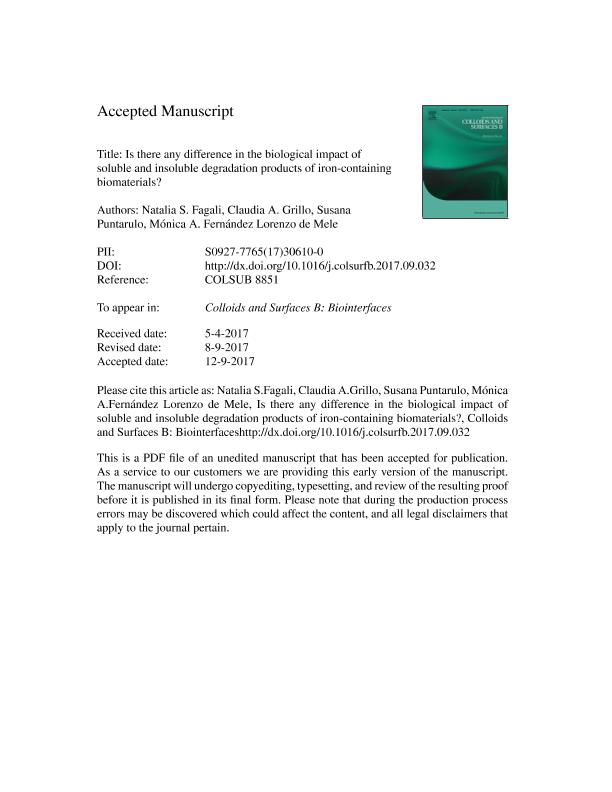Mostrar el registro sencillo del ítem
dc.contributor.author
Fagali, Natalia Soledad

dc.contributor.author
Grillo, Claudia Alejandra

dc.contributor.author
Puntarulo, Susana Ángela

dc.contributor.author
Fernandez Lorenzo, Monica Alicia

dc.date.available
2018-11-08T15:03:17Z
dc.date.issued
2017-12
dc.identifier.citation
Fagali, Natalia Soledad; Grillo, Claudia Alejandra; Puntarulo, Susana Ángela; Fernandez Lorenzo, Monica Alicia; Is there any difference in the biological impact of soluble and insoluble degradation products of iron-containing biomaterials?; Elsevier Science; Colloids and Surfaces B: Biointerfaces; 160; 12-2017; 238-246
dc.identifier.issn
0927-7765
dc.identifier.uri
http://hdl.handle.net/11336/63970
dc.description.abstract
The interactions that could be built between the biomaterials and tissue- microenvironments are very complex, especially in case of degradable metals that generate a broad variety of degradation products. The interfacial problems are particularly relevant for Fe-based materials that have been proposed for the development of biodegradable implants. The cell metabolism could be affected by the accumulation of insoluble Fe-containing degradation products that has been observed in vitro and in vivo as a coarse granular brownish material around the implant. However, the relative importance of each Fe-species (soluble and insoluble) on the cellular behavior of the surrounding cells, particularly on the generation of reactive species (RS), is not completely elucidated. The aim of this study is to evaluate the processes occurring at the Fe-biomaterial/cells interfacial region, and to discriminate the effects of soluble and insoluble corrosion products released by the bulk metal (Fe- microparticles (Fe0p) or Fe0 ring) on the adjacent cells, mainly in relation to RS generation. With this purpose Fe0p and Fe0 ring were incubated with fibroblast cells (BALB/c 3T3 line) for 24 and 48 h periods. Then different techniques were used, such as the dichlorofluorescein diacetate assay (DCFH2-DA) for detection of RS, acridine orange dye for cell viability, total protein content determinations, Prussian Blue staining and TEM observations. To individualize the effects of soluble and insoluble species, independent experiments with Fe3+-salts were performed. Overall data indicate that RS generation by cells exposed to the degradation products of Fe-based biomaterials is more dependent on the presence of insoluble products than on soluble Fe species.
dc.format
application/pdf
dc.language.iso
eng
dc.publisher
Elsevier Science

dc.rights
info:eu-repo/semantics/openAccess
dc.rights.uri
https://creativecommons.org/licenses/by-nc-nd/2.5/ar/
dc.subject
Biodegradable
dc.subject
Biomaterials
dc.subject
Interface
dc.subject
Iron
dc.subject
Reactive Species
dc.subject.classification
Otras Biotecnologías de la Salud

dc.subject.classification
Biotecnología de la Salud

dc.subject.classification
CIENCIAS MÉDICAS Y DE LA SALUD

dc.title
Is there any difference in the biological impact of soluble and insoluble degradation products of iron-containing biomaterials?
dc.type
info:eu-repo/semantics/article
dc.type
info:ar-repo/semantics/artículo
dc.type
info:eu-repo/semantics/publishedVersion
dc.date.updated
2018-10-22T22:31:48Z
dc.journal.volume
160
dc.journal.pagination
238-246
dc.journal.pais
Países Bajos

dc.journal.ciudad
Amsterdam
dc.description.fil
Fil: Fagali, Natalia Soledad. Consejo Nacional de Investigaciones Científicas y Técnicas. Centro Científico Tecnológico Conicet - La Plata. Instituto de Investigaciones Fisicoquímicas Teóricas y Aplicadas. Universidad Nacional de La Plata. Facultad de Ciencias Exactas. Instituto de Investigaciones Fisicoquímicas Teóricas y Aplicadas; Argentina
dc.description.fil
Fil: Grillo, Claudia Alejandra. Consejo Nacional de Investigaciones Científicas y Técnicas. Centro Científico Tecnológico Conicet - La Plata. Instituto de Investigaciones Fisicoquímicas Teóricas y Aplicadas. Universidad Nacional de La Plata. Facultad de Ciencias Exactas. Instituto de Investigaciones Fisicoquímicas Teóricas y Aplicadas; Argentina
dc.description.fil
Fil: Puntarulo, Susana Ángela. Consejo Nacional de Investigaciones Científicas y Técnicas. Oficina de Coordinación Administrativa Houssay. Instituto de Bioquímica y Medicina Molecular. Universidad de Buenos Aires. Facultad Medicina. Instituto de Bioquímica y Medicina Molecular; Argentina
dc.description.fil
Fil: Fernandez Lorenzo, Monica Alicia. Universidad Nacional de La Plata. Facultad de Ingeniería; Argentina. Consejo Nacional de Investigaciones Científicas y Técnicas. Centro Científico Tecnológico Conicet - La Plata. Instituto de Investigaciones Fisicoquímicas Teóricas y Aplicadas. Universidad Nacional de La Plata. Facultad de Ciencias Exactas. Instituto de Investigaciones Fisicoquímicas Teóricas y Aplicadas; Argentina
dc.journal.title
Colloids and Surfaces B: Biointerfaces

dc.relation.alternativeid
info:eu-repo/semantics/altIdentifier/doi/http://dx.doi.org/10.1016/j.colsurfb.2017.09.032
dc.relation.alternativeid
info:eu-repo/semantics/altIdentifier/url/https://www.sciencedirect.com/science/article/pii/S0927776517306100
Archivos asociados
